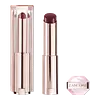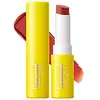Lancôme Lip Idôle Squalane-12 Butterglow Hydrating Lip Balm Versus Supergoop! Lipshade 100% Mineral Lip Color SPF 30
What's inside
What's inside
 Key Ingredients
Key Ingredients

 Benefits
Benefits

 Concerns
Concerns

 Ingredients Side-by-side
Ingredients Side-by-side

Polyglyceryl-2 Triisostearate
EmulsifyingSqualane
EmollientBis-Behenyl/Isostearyl/Phytosteryl Dimer Dilinoleyl Dimer Dilinoleate
EmollientButyrospermum Parkii Butter
Skin ConditioningCellulose
AbsorbentDimer Dilinoleyl Dimer Dilinoleate
EmollientPolyglyceryl-3 Beeswax
EmulsifyingHelianthus Annuus Seed Cera
EmollientHydrogenated Castor Oil Dimer Dilinoleate
Skin ConditioningSimmondsia Chinensis Butter
Skin ConditioningHydrogenated Jojoba Oil
AbrasiveCandelilla Cera
EmollientRosa Centifolia Extract
Skin ConditioningCamelina Sativa Seed Oil
Skin ConditioningCanola Oil
EmollientMentha Piperita Oil
MaskingCeramide NP
Skin ConditioningSaccharomyces Ferment Filtrate
HumectantSilica
AbrasiveAluminum Hydroxide
EmollientPropylene Glycol
HumectantCitric Acid
BufferingTocopherol
AntioxidantPentaerythrityl Tetra-Di-T-Butyl Hydroxyhydrocinnamate
AntioxidantCI 45380
Cosmetic ColorantCI 45410
Cosmetic ColorantCI 15850
Cosmetic ColorantCI 77891
Cosmetic ColorantCI 19140
Cosmetic ColorantLimonene
PerfumingBenzyl Benzoate
AntimicrobialParfum
MaskingPolyglyceryl-2 Triisostearate, Squalane, Bis-Behenyl/Isostearyl/Phytosteryl Dimer Dilinoleyl Dimer Dilinoleate, Butyrospermum Parkii Butter, Cellulose, Dimer Dilinoleyl Dimer Dilinoleate, Polyglyceryl-3 Beeswax, Helianthus Annuus Seed Cera, Hydrogenated Castor Oil Dimer Dilinoleate, Simmondsia Chinensis Butter, Hydrogenated Jojoba Oil, Candelilla Cera, Rosa Centifolia Extract, Camelina Sativa Seed Oil, Canola Oil, Mentha Piperita Oil, Ceramide NP, Saccharomyces Ferment Filtrate, Silica, Aluminum Hydroxide, Propylene Glycol, Citric Acid, Tocopherol, Pentaerythrityl Tetra-Di-T-Butyl Hydroxyhydrocinnamate, CI 45380, CI 45410, CI 15850, CI 77891, CI 19140, Limonene, Benzyl Benzoate, Parfum
Zinc Oxide 17.5%
Cosmetic ColorantRicinus Communis Seed Oil
MaskingCaprylic/Capric Triglyceride
MaskingJojoba Esters
EmollientEuphorbia Cerifera Wax
Persea Gratissima Oil
Skin ConditioningBis-Diglyceryl Polyacyladipate-2
EmollientAroma
Simmondsia Chinensis Seed Oil
EmollientArgania Spinosa Kernel Oil
EmollientTocopheryl Acetate
AntioxidantCopernicia Cerifera Wax
Stevioside
MaskingCetearyl Ethylhexanoate
EmollientSynthetic Fluorphlogopite
Isostearic Acid
CleansingLecithin
EmollientPolyhydroxystearic Acid
EmulsifyingPolyglyceryl-3 Polyricinoleate
EmulsifyingButyrospermum Parkii Butter
Skin ConditioningMangifera Indica Seed Butter
Skin ConditioningAstrocaryum Murumuru Seed Butter
EmollientCalcium Sodium Borosilicate
Rosa Canina Fruit Oil
EmollientSorbitan Isostearate
EmulsifyingBisabolol
MaskingVaccinium Macrocarpon Seed Oil
Skin ConditioningPortulaca Pilosa Extract
Skin ConditioningTocopherol
AntioxidantAscorbyl Palmitate
AntioxidantSucrose Cocoate
EmulsifyingGlycine Soja Oil
EmollientPalmitoyl Tripeptide-38
Skin ConditioningTin Oxide
AbrasiveTitanium Dioxide
Cosmetic ColorantCI 45410
Cosmetic ColorantIron Oxides
CI 19140
Cosmetic ColorantCI 15850
Cosmetic ColorantCI 15985
Cosmetic ColorantCI 42090
Cosmetic ColorantZinc Oxide 17.5%, Ricinus Communis Seed Oil, Caprylic/Capric Triglyceride, Jojoba Esters, Euphorbia Cerifera Wax, Persea Gratissima Oil, Bis-Diglyceryl Polyacyladipate-2, Aroma, Simmondsia Chinensis Seed Oil, Argania Spinosa Kernel Oil, Tocopheryl Acetate, Copernicia Cerifera Wax, Stevioside, Cetearyl Ethylhexanoate, Synthetic Fluorphlogopite, Isostearic Acid, Lecithin, Polyhydroxystearic Acid, Polyglyceryl-3 Polyricinoleate, Butyrospermum Parkii Butter, Mangifera Indica Seed Butter, Astrocaryum Murumuru Seed Butter, Calcium Sodium Borosilicate, Rosa Canina Fruit Oil, Sorbitan Isostearate, Bisabolol, Vaccinium Macrocarpon Seed Oil, Portulaca Pilosa Extract, Tocopherol, Ascorbyl Palmitate, Sucrose Cocoate, Glycine Soja Oil, Palmitoyl Tripeptide-38, Tin Oxide, Titanium Dioxide, CI 45410, Iron Oxides, CI 19140, CI 15850, CI 15985, CI 42090
 Reviews
Reviews

Ingredients Explained
These ingredients are found in both products.
Ingredients higher up in an ingredient list are typically present in a larger amount.
This ingredient is also known as shea butter. It is an effective skin hydrator and emollient.
Emollients help soothe and soften your skin. It does this by creating a protective film on your skin. This barrier helps trap moisture and keeps your skin hydrated. Emollients may be effective at treating dry or itchy skin.
Shea butter is rich in antioxidants. Antioxidants help fight free-radicals, or molecules that may harm the body. It is also full of fatty acids including stearic acid and linoleic acid. These acids help replenish the skin and keep skin moisturized.
While Shea Butter has an SPF rating of about 3-4, it is not a sunscreen replacement.
Shea butter may not be fungal acne safe. We recommend speaking with a professional if you have any concerns.
Learn more about Butyrospermum Parkii ButterCi 15850 is the pigment color red. It is an azo dye and created synthetically.
Azo dyes need to be thoroughly purified before use. This allows them to be more stable and longer-lasting.
This ingredient is common in foundations, lipsticks, and blushes. This color is described as brown/orangey red.
It has many secondary names such as Red 6 and Red 7. According to a manufacturer, Red 6 usually contains aluminum.
Learn more about CI 15850CI 19140 is also known as Tartrazine. Tartrazine is a synthetic dye used in cosmetics, foods, and medicine to add a yellow color.
Tartrazine is created from petroleum and is water-soluble.
Some people may experience allergies from this dye, especially asthmatics and those with an aspirin intolerance.
Learn more about CI 19140CI 45410 is a synthetic red-pigment and dye.
It often goes by both Red 28 or Red 27; manufacturers label both ingredients as CI 45410.
This dye is commonly found in makeup because it imparts a vivid color. Some types of this dye change color based on pH level and interaction with moisture:
Your skin has a natural pH of around 4.5 - 5.5.
According to the FDA, CI 45410 is not permitted for use in eye products.
Red 27 is a flourescein dye and commonly used as a fluorescent tracer in medicine.
Learn more about CI 45410Tocopherol (also known as Vitamin E) is a common antioxidant used to help protect the skin from free-radicals and strengthen the skin barrier. It's also fat soluble - this means our skin is great at absorbing it.
Vitamin E also helps keep your natural skin lipids healthy. Your lipid skin barrier naturally consists of lipids, ceramides, and fatty acids. Vitamin E offers extra protection for your skin’s lipid barrier, keeping your skin healthy and nourished.
Another benefit is a bit of UV protection. Vitamin E helps reduce the damage caused by UVB rays. (It should not replace your sunscreen). Combining it with Vitamin C can decrease sunburned cells and hyperpigmentation after UV exposure.
You might have noticed Vitamin E + C often paired together. This is because it is great at stabilizing Vitamin C. Using the two together helps increase the effectiveness of both ingredients.
There are often claims that Vitamin E can reduce/prevent scarring, but these claims haven't been confirmed by scientific research.
Learn more about Tocopherol